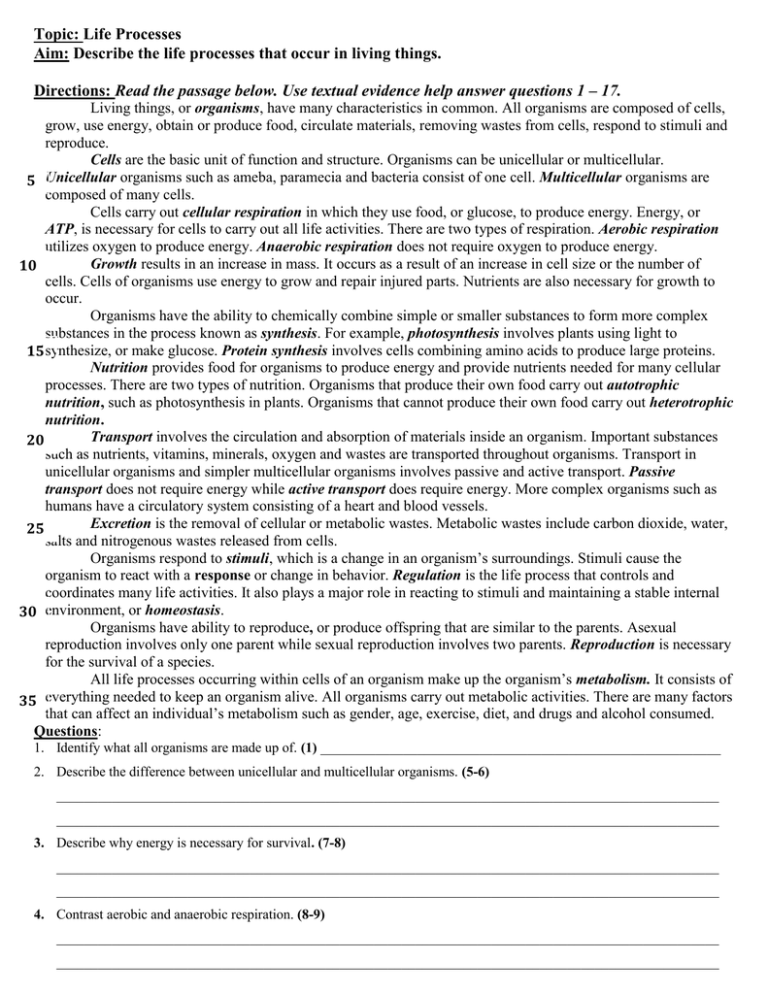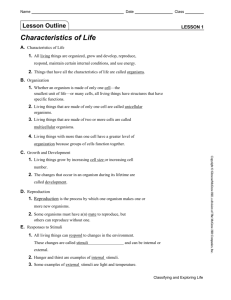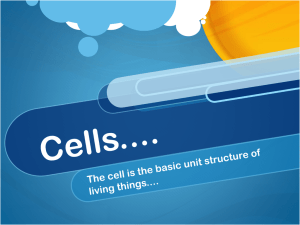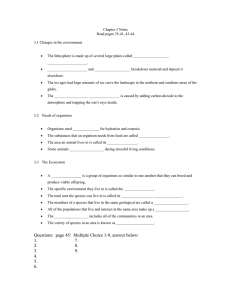Life Processes
advertisement

Topic: Life Processes Aim: Describe the life processes that occur in living things. Directions: Read the passage below. Use textual evidence help answer questions 1 – 17. Living things, or organisms, have many characteristics in common. All organisms are composed of cells, grow, use energy, obtain or produce food, circulate materials, removing wastes from cells, respond to stimuli and reproduce. Cells are the basic unit of function and structure. Organisms can be unicellular or multicellular. 5 Unicellular organisms such as ameba, paramecia and bacteria consist of one cell. Multicellular organisms are composed of many cells. Cells carry out cellular respiration in which they use food, or glucose, to produce energy. Energy, or ATP, is necessary for cells to carry out all life activities. There are two types of respiration. Aerobic respiration utilizes oxygen to produce energy. Anaerobic respiration does not require oxygen to produce energy. Growth results in an increase in mass. It occurs as a result of an increase in cell size or the number of 10 cells. Cells of organisms use energy to grow and repair injured parts. Nutrients are also necessary for growth to occur. Organisms have the ability to chemically combine simple or smaller substances to form more complex substances in the process known as synthesis. For example, photosynthesis involves plants using light to 15 synthesize, or make glucose. Protein synthesis involves cells combining amino acids to produce large proteins. Nutrition provides food for organisms to produce energy and provide nutrients needed for many cellular processes. There are two types of nutrition. Organisms that produce their own food carry out autotrophic nutrition, such as photosynthesis in plants. Organisms that cannot produce their own food carry out heterotrophic nutrition. Transport involves the circulation and absorption of materials inside an organism. Important substances 20 such as nutrients, vitamins, minerals, oxygen and wastes are transported throughout organisms. Transport in unicellular organisms and simpler multicellular organisms involves passive and active transport. Passive transport does not require energy while active transport does require energy. More complex organisms such as humans have a circulatory system consisting of a heart and blood vessels. Excretion is the removal of cellular or metabolic wastes. Metabolic wastes include carbon dioxide, water, 25 salts and nitrogenous wastes released from cells. Organisms respond to stimuli, which is a change in an organism’s surroundings. Stimuli cause the organism to react with a response or change in behavior. Regulation is the life process that controls and coordinates many life activities. It also plays a major role in reacting to stimuli and maintaining a stable internal 30 environment, or homeostasis. Organisms have ability to reproduce, or produce offspring that are similar to the parents. Asexual reproduction involves only one parent while sexual reproduction involves two parents. Reproduction is necessary for the survival of a species. All life processes occurring within cells of an organism make up the organism’s metabolism. It consists of everything needed to keep an organism alive. All organisms carry out metabolic activities. There are many factors 35 that can affect an individual’s metabolism such as gender, age, exercise, diet, and drugs and alcohol consumed. Questions: 1. Identify what all organisms are made up of. (1) __________________________________________________________ 2. Describe the difference between unicellular and multicellular organisms. (5-6) ________________________________________________________________________________________________ ________________________________________________________________________________________________ 3. Describe why energy is necessary for survival. (7-8) ________________________________________________________________________________________________ ________________________________________________________________________________________________ 4. Contrast aerobic and anaerobic respiration. (8-9) ________________________________________________________________________________________________ ________________________________________________________________________________________________ 5. Identify what is necessary for growth to occur. (11)_______________________________________________________ ________________________________________________________________________________________________ 6. Describe the life process of synthesis. (13-14) ___________________________________________________________ ________________________________________________________________________________________________ 7. Identify an example of synthesis that occurs in organisms and identify the substance that is produced. (14-15) ________________________________________________________________________________________________ 8. Why is nutrition necessary for survival? (16-17) ________________________________________________________________________________________________ ________________________________________________________________________________________________ ________________________________________________________________________________________________ 9. Describe the difference between the two types of nutrition. (17-19) ________________________________________________________________________________________________ ________________________________________________________________________________________________ _______________________________________________________________________________________________ 10. Identify the life process that involves the absorption and circulation of materials inside an organism. (20) ________________________________________________________________________________________________ 11. Contrast passive and active transport. (22-23) ________________________________________________________________________________________________ ________________________________________________________________________________________________ 12. Identify the types of wastes that are excreted from the body. (25) ___________________________________________ 13. Identify four examples of metabolic wastes excreted from the body. (25-26) ________________________________________________________________________________________________ ________________________________________________________________________________________________ 14. Identify a change in the environment that organisms can detect. (27) _________________________________________ 15. Describe the life process of regulation. (28-29) ________________________________________________________________________________________________ ________________________________________________________________________________________________ 16. Describe homeostasis. (29-30) _______________________________________________________________________ ________________________________________________________________________________________________ 17. Contrast asexual and sexual reproduction. (31-32) ________________________________________________________________________________________________ ________________________________________________________________________________________________ 18. Is reproduction necessary for survival? Support your answer. (32-33) ________________________________________________________________________________________________ ________________________________________________________________________________________________ 19. Describe what makes up an organism’s metabolism. (34) ________________________________________________________________________________________________ ________________________________________________________________________________________________ 20. Identify the factors that can affect your metabolism. (35-36) ________________________________________________________________________________________________ Name __________________________________________ Date _________ Period ________ Life Processes Review Directions: Write the name of the life processes described. 1. Identify the life process in which organisms produce their own food. __________________________ 2. Identify the process that circulates substances throughout the body. _______________________________ 3. Which life process is necessary for the survival of a species? ________________________________________ 4. Identify the process that represents the sum total of life processes. ________________________________ 5. Identify the life process in which proteins are produced by combining amino acids. _____________________________________________________ 6. Which type of respiration does not use oxygen to produce energy? _________________________________ 7. Identify the life process that provides food used to produce energy during the process of respiration. _______________________________________________ 8. Which type of transport does not require energy? Which type of transport does require energy? ______________________________________________________ 9. Which life process involves an increase in cell size or cell number? ________________________________ 10. Identify the life process that involves the removal of metabolic wastes such as carbon dioxide. _____________________________________________________ 11. Identify the life process that produces energy. _______________________________________________ 12. Which life process involves the control and coordination of all life processes? _______________________________________________________ 13. Which type of nutrition is used by organisms that must ingest food because they cannot produce their own food? _______________________________________________________________________ 14. Identify the type of respiration that uses oxygen. ________________________________________________







